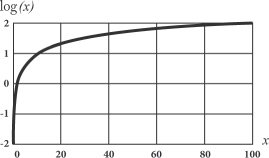9.1.7 The dB Scale
The decibel (dB) is a convenient and commonly adopted unit to compare quantities exhibiting a large range in magnitude. This is in particular true if the system response is proportional not to the quantity but rather to the logarithm of the quantity. The most common example is probably the human ear. Human ear responds to air pressure coming from a sound. This pressure varies within an extremely large scale. If the ear response was linearly proportional to air pressure and tuned for the best reception of regular human speech volume, the humans would be deaf to the rustling grass and might not survive the noise of an aircraft. Instead, the response of the ear is proportional to the logarithm of air pressure. Figure 9.1.12 shows a plot of the logarithm function. This function emphasizes small values and suppresses large ones. For instance, if a quantity changes by two orders of magnitude, then logarithm changes by a factor of ![]() times.
times.

Figure 9.1.12 Logarithm function.
Prior to discussing the dB scale one is to make an observation. As seen from (9.1.35) the power flux is proportional to the square of the electric field intensity. Another example of a squared functional relation is known from elementary physics. Namely, the power P of a direct electric current ...
Get GPS Satellite Surveying, 4th Edition now with the O’Reilly learning platform.
O’Reilly members experience books, live events, courses curated by job role, and more from O’Reilly and nearly 200 top publishers.

